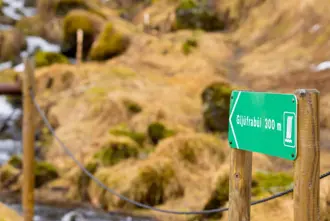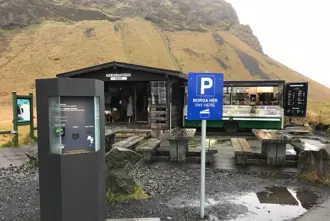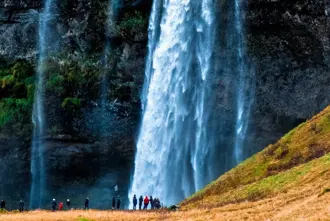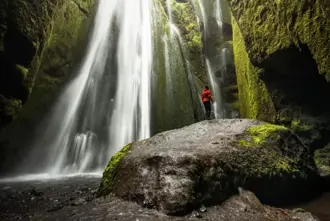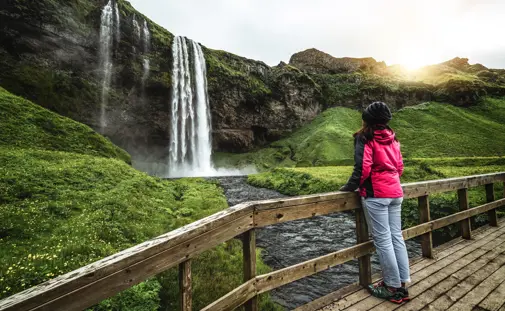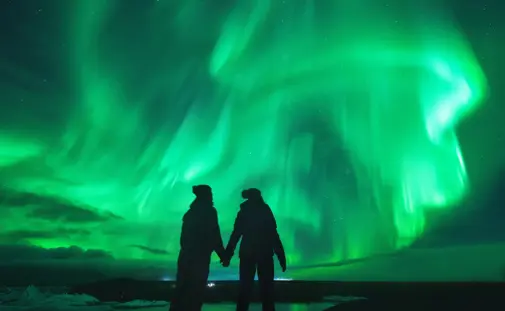Gljúfrabúi Waterfall
Gljúfrabúi, meaning "Canyon Dweller," is a hidden waterfall in South Iceland. It's located near the famous Seljalandsfoss waterfall. Unlike its neighbor, Gljúfrabúi is tucked away behind a cliff, making it less visible and often missed by travelers. This hidden location adds to its charm, offering visitors a more secluded and intimate experience.
Gljúfrabúi Facts & Figures
- Location: South Iceland, approximately 150 meters north of Seljalandsfoss, along Route 249.
- Height: Approximately 40 meters (131 feet).
- River Source: Gljúfurá River, originating from springs north of Tröllagil (Troll Gorge) in the Hamragarðaheiði heath.
- Accessibility: Partially hidden behind a large cliff; visitors can enter a narrow canyon to view the waterfall up close.
- Availability: Open free of charge to everyone.
- Parking: Paid parking with facilities available at Seljalandsfoss.
Gljúfrabúi Geology
Gljúfrabúi is part of the dynamic landscape shaped by Iceland's volcanic activity and glacial movements. The waterfall flows from the Gljúfurá River, a spring-fed river that is less voluminous than its neighbor, the Seljalandsá River. The river's source is north of Tröllagil (Troll Gorge) Canyon in the heath Hamragarðaheiði. The waterfall is partially obscured by palagonite rock formations, which are characteristic of the region. These formations were created by volcanic activity and subsequent erosion over millennia. The boulder that blocks the waterfall is called Franskanef. The surrounding cliffs and narrow canyon have been carved by the persistent flow of water, creating a secluded enclave that houses the waterfall.
Folklore
Icelandic folklore often intertwines with its natural landscapes, and Gljúfrabúi is no exception. The name "Gljúfrabúi" translates to "Canyon Dweller," suggesting tales of hidden beings residing within the gorge. The secluded nature of the waterfall, hidden behind cliffs and accessible through a narrow canyon, lends itself to stories of elves and hidden people, known as "huldufólk" in Icelandic tradition. These tales add an air of mystery and enchantment to the site, inviting visitors to imagine the unseen inhabitants of this secluded spot.
I couldn't find specific stories or folklore related to the waterfall but locals in the area and local guides might have some stories to pass on to you.
What to Expect When Visiting Gljúfrabúi
Visiting Gljúfrabúi offers a unique experience compared to more exposed waterfalls. To reach the waterfall, visitors typically start from the parking area near Seljalandsfoss. From there, it's a short walk of about 150 meters north along a well-trodden path. The path leads to the entrance of a narrow canyon, where the sound of cascading water grows louder as you approach. To view Gljúfrabúi up close, you'll need to navigate through the canyon. This involves stepping on stones and wading through shallow water, so waterproof footwear is recommended. The interior can be slippery, and water spray is constant, so protective clothing and care are advised. There are no facilities directly at Gljúfrabúi. However, the nearby Seljalandsfoss area offers amenities such as restrooms and a small café. Information signs about the waterfalls are present near Seljalandsfoss but are limited near Gljúfrabúi. Visitors often spend about 30 minutes to an hour exploring Gljúfrabúi, depending on their interest and the time taken to navigate the canyon.
Hiking Path from Gljúfrabúi to Seljalandsfoss
Gljúfrabúi and Seljalandsfoss are in close proximity, making it convenient to visit both. A well-marked easy hiking path connects the two waterfalls, approximately a 10-minute walk apart. The trail is relatively flat and easy to navigate, suitable for most visitors. Along the way, you'll be treated to views of the surrounding landscape, including lush fields and distant mountains. This short walk allows visitors to experience two distinct waterfalls within a brief period.
Where is Gljúfrabúi Located?
Gljúfrabúi is situated in South Iceland, along Route 249, also known as Þórsmerkurvegur. It's approximately 1.5 to 2 hours by car from Reykjavik, making it accessible for day trips. The waterfall is part of the Seljalandsá River system, which originates from the Eyjafjallajökull Glacier. Its location near the Ring Road makes it a convenient stop for travelers exploring Iceland's south coast.
Exact GPS Coordinates: 63°37'15.9"N 19°59'11.0"W
Take Þórsmerkurvegur (Thorsmork Road) to Reach Gljúfrabúi
To reach Gljúfrabúi, travelers take Route 1 (the Ring Road) to Route 249, known as Þórsmerkurvegur (road to Thorsmork). This road leads directly to the Seljalandsfoss parking area. Þórsmerkurvegur is a paved road in good condition, suitable for all vehicle types. Clear signage along the route directs visitors to both Seljalandsfoss and Gljúfrabúi. During winter months, it's advisable to check road conditions, as weather can affect accessibility.
Gljúfrabúi Waterfall Parking
- Paid Parking
- Located next to Seljalandsfoss
- Public Bathrooms
Gljúfrabúi shares a parking area with Seljalandsfoss, which is the main designated spot for visitors arriving by car. The parking lot is located right off Route 249 and is easy to find, with clear signage directing travelers toward the area. The lot itself is gravel, spacious, and designed to accommodate a large number of vehicles. However, during peak season, especially in the summer months, it can fill up quickly as tourists flock to see the waterfalls.
Parking at this site is not free. A flat fee is required, which covers the duration of the visit. Payment machines are set up in the parking area, allowing visitors to pay upon arrival. The fee helps maintain the site, funding restroom facilities, walking paths, and other necessary upkeep. While the system is convenient, those unfamiliar with it should be aware that the machines accept both cash and card, though card payment is recommended to avoid potential issues with Icelandic currency.
From the parking lot, it’s only a short walk to Gljúfrabúi. The waterfall is a few hundered meters north of Seljalandsfoss, making it an easy and quick stroll along a well-trodden path. The area around the parking lot offers some basic amenities. There is a small café where visitors can grab coffee or a snack, along with public restrooms. However, Gljúfrabúi itself does not have any facilities, so travelers should plan accordingly before heading toward the waterfall.
For those wanting to enjoy a quieter visit, arriving early in the morning or later in the evening is best. The site tends to be busiest during midday when tour buses stop at Seljalandsfoss. The later hours, particularly in summer, offer the added benefit of long daylight hours, while in winter, visiting in the late evening might provide an opportunity to see the Northern Lights.
Nearby Attractions to Gljúfrabúi
Gljúfrabúi sits in an area packed with natural wonders and historical sites. Whether you’re exploring more waterfalls, hiking to hidden gems, or learning about Iceland’s volcanic past, there’s plenty to see nearby.
Just 150 meters away stands Seljalandsfoss, one of Iceland’s most famous waterfalls. It cascades 60 meters (197 feet) down a cliff, but what makes it unique is the ability to walk behind the waterfall. The pathway behind the curtain of water allows visitors to see Seljalandsfoss from an angle rarely experienced with waterfalls of this size. During winter, however, this path can be icy and slippery, making it less accessible.
For those seeking a quieter waterfall, Sauðafoss, located 4 km away, is an excellent choice. It is far less visited, meaning visitors can enjoy the peaceful atmosphere and take in the surrounding landscapes without the crowds that typically gather at Seljalandsfoss.
A completely different type of attraction is the DC-3 Airplane Wreck in Eyvindarholt. This site, located about 5 minute drive or a good one hour walk away from Gljúfrabúi, features the remains of a U.S. Navy Douglas DC-3 aircraft that crashed during landing in 1969. Fortunately everyone got away safely.
The wreckage has been left untouched on the plain for guests and photographers to enjoy. To reach the site is easy, simply park at the dedicated lot and walk a few meters to the plane.
For a more adventurous stop, Nauthúsagil Canyon and Nauthúsafoss is a hidden gem just 10 km from Gljúfrabúi. The canyon is narrow and covered in lush green moss, creating a magical setting. The hike inside is not easy—it involves scrambling over rocks and using chains fixed to the canyon walls to navigate slippery sections. At the end of the trail, hikers are rewarded with the stunning Nauthúsafoss, a small but picturesque waterfall tucked deep inside the canyon.
For those interested in Iceland’s volcanic history, the Lava Center in Hvolsvöllur, 27 km west of Gljúfrabúi, provides an interactive learning experience. This museum focuses on Iceland’s geology, volcanic eruptions, and earthquake activity. Visitors can see simulations of lava flows, earthquake sensors, and models of past eruptions, making it an educational stop for those fascinated by Iceland’s active landscape.
About 30 km east of Gljúfrabúi, the Skógar Museum and Skógafoss Waterfall are two attractions worth visiting. Skógar Museum is a folk museum showcasing Icelandic culture, featuring traditional turf houses, artifacts, and fishing equipment used by early settlers. Just a short walk away is Skógafoss, another 60-meter-high waterfall with a much wider cascade than Seljalandsfoss. A staircase with over 500 steps leads to an observation platform at the top, providing breathtaking views of the waterfall and surrounding landscapes.
Can You See the Northern Lights from Gljúfrabúi?
Gljúfrabúi is an excellent location for viewing the Northern Lights when conditions are right. The area has minimal light pollution, especially at night when the nearby Seljalandsfoss parking area quiets down. Since there are no large towns nearby, the dark skies make it easier to spot the auroras when they appear.
The best time to see the Northern Lights in Iceland is between September and April, when the nights are long enough to provide darkness for the auroras to be visible. However, clear skies are necessary, so it’s essential to check the weather forecast and aurora activity predictions before heading out.
The best strategy for Northern Lights viewing at Gljúfrabúi is to find a dark, open area away from car headlights. The open fields near the parking area offer great vantage points, while the canyon itself may limit visibility. If possible, visitors should bring a tripod and a camera with long exposure settings, as photographing the auroras can be tricky without proper equipment.
It’s important to dress appropriately. Even though Iceland’s South Coast doesn’t experience the harshest winter temperatures, it can still be cold and windy, especially at night. Wearing thermal layers, a windproof jacket, gloves, and a hat is necessary to stay comfortable while waiting for the lights to appear.
For the best chance of witnessing the auroras, staying overnight in the area or planning visits on multiple nights increases the likelihood of catching a good display. The unpredictability of the Northern Lights means patience is key, but when they do appear over the Icelandic sky, they create a truly unforgettable experience.
- Náttúrufræðistofnun Íslands. (n.d.). Seljalandsfoss og Gljúfrabúi. Retrieved February 10, 2025, from Seljalandsfoss og Gljúfrabúi | Náttúrufræðistofnun Íslands





